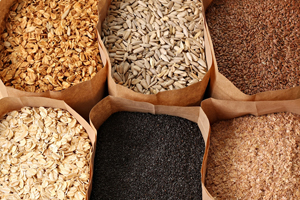A new study concludes that eating whole grains is healthier than not eating whole grains and helps you live longer.1 Geng Zong, Alisa Gao, Frank B. Hu, Qi Sun. “Whole Grain Intake and Mortality From All Causes, Cardiovascular Disease, and Cancer. A Meta-Analysis of Prospective Cohort Studies.” Circulation. 2016; 133: 2370-2380. http://circ.ahajournals.org/content/133/24/2370.abstract Most people would think this is fairly obvious and not worth a study. But in fact, astoundingly, what the study looked at is not only not obvious–it’s absurd. It has a hole in it so big, you could sail all 70 ships of the Seventh Fleet through it–abreast. Nevertheless, there is useful information to be gleaned from it.
The Whole Grain Study
According to the researchers, who are all affiliated with Harvard’s T.H. Chan School of Public Health in Boston, whole grains are rich in dietary fiber, vitamins, minerals, phytochemicals, and other bioactive compounds that may favor long-term health. As a result, dietary guidelines around the world have included whole grains as an essential component of a healthy diet.2 Mario G. Ferruzzi, Satya S. Jonnalagadda, Simin Liu, et al. “Developing a Standard Definition of Whole-Grain Foods for Dietary Recommendations: Summary Report of a Multidisciplinary Expert Roundtable Discussion.” Adv Nutr vol. 5: 164-176, 2014. http://advances.nutrition.org/content/5/2/164.full Nevertheless, consumption is largely below recommended levels in the United States and many European countries. For example, whole grain intake among U.S. adults remains less than one serving a day, despite the long-time recommendation in Dietary Guidelines for Americans to consume 3 or more servings per day.3 McGill CR, Fulgoni VL 3rd, Devareddy L. “Ten-year trends in fiber and whole grain intakes and food sources for the United States population: National Health and Nutrition Examination Survey 2001-2010.” Nutrients. 2015 Feb 9;7(2):1119-30. http://www.ncbi.nlm.nih.gov/pmc/articles/PMC4344579/
Whole grain intake among U.S. adults remains less than 1/3 the recommended amount. @BaselineHealth
The researchers also noted that despite the obvious nature of these recommendations, there are, surprisingly, virtually no large-scale intervention studies investigating the effects of whole grain intake on chronic disease risk that would support these omnipresent dietary recommendations. The supporting evidence for the health benefits of whole grains actually comes from prospective cohort studies. Previous meta-analyses of prospective studies have consistently reported inverse associations between whole grain intake and type 2 diabetes mellitus,4 Ye EQ, Chacko SA, Chou EL, Kugizaki M, Liu S. “Greater whole-grain intake is associated with lower risk of type 2 diabetes, cardiovascular disease, and weight gain.” J Nutr. 2012;142:1304–1313. http://jn.nutrition.org/content/142/7/1304.full , 5 de Munter JS, Hu FB, Spiegelman D, et al. “Whole grain, bran, and germ intake and risk of type 2 diabetes: a prospective cohort study and systematic review.” PLoS Med. 2007;4:e261. http://journals.plos.org/plosmedicine/article?id=10.1371/journal.pmed.0040261 , 6 Aune D, Norat T, Romundstad P, Vatten LJ. “Whole grain and refined grain consumption and the risk of type 2 diabetes: a systematic review and dose-response meta-analysis of cohort studies.” Eur J Epidemiol. 2013;28:845–858. http://link.springer.com/article/10.1007/s10654-013-9852-5 , 7 Chanson-Rolle A, Meynier A, Aubin F, et al. “Systematic review and meta-analysis of human studies to support a quantitative recommendation for whole grain intake in relation to type 2 diabetes.” PLoS One. 2015;10:e0131377. http://journals.plos.org/plosone/article?id=10.1371/journal.pone.0131377 cardiovascular diseases (CVDs), 8 Ye , 9 Tang G, Wang D, Long J, Yang F, Si L. “Meta-analysis of the association between whole grain intake and coronary heart disease risk.” Am J Cardiol. 2015;115:625–629. http://www.ncbi.nlm.nih.gov/pubmed/25727082 , 10 Mellen PB, Walsh TF, Herrington DM. “Whole grain intake and cardiovascular disease: a meta-analysis.” Nutr Metab Cardiovasc Dis. 2008;18:283–290. http://www.ncbi.nlm.nih.gov/pubmed/17449231 and certain cancers,11 Jacobs DR Jr., Marquart L, Slavin J, Kushi LH. “Whole-grain intake and cancer: an expanded review and meta-analysis.” Nutr Cancer. 1998;30:85–96. http://www.ncbi.nlm.nih.gov/pubmed/9589426 , 12 Aune D, Chan DS, Lau R, et al. “Dietary fibre, whole grains, and risk of colorectal cancer: systematic review and dose-response meta-analysis of prospective studies.” BMJ. 2011;343:d6617. http://www.bmj.com/content/343/bmj.d6617.abstract?ijkey=7acaff60416509b6c4ccd5d59c510e4926652b88&keytype2=tf_ipsecsha , 13 Haas P, Machado MJ, Anton AA, et al. “Effectiveness of whole grain consumption in the prevention of colorectal cancer: meta-analysis of cohort studies.” Int J Food Sci Nutr. 2009;60(suppl 6):1–13. http://www.tandfonline.com/doi/abs/10.1080/09637480802183380 which, taken together, are among the major global causes of death. However, existing findings on whole grain intake and mortality have, until now, remained largely inconclusive. Although several studies observed significant inverse associations between whole grain intake and both total and CVD mortality,14 Fraser GE, Sabaté J, Beeson WL, Strahan TM. “A possible protective effect of nut consumption on risk of coronary heart disease: the Adventist Health Study.” Arch Intern Med. 1992;152:1416–1424. http://archinte.jamanetwork.com/article.aspx?articleid=616417 , 15 Jacobs DR Jr., Meyer HE, Solvoll K. “Reduced mortality among whole grain bread eaters in men and women in the Norwegian County Study.” Eur J Clin Nutr. 2001;55:137–143. http://www.nature.com/ejcn/journal/v55/n2/pdf/1601133a.pdf , 16 Sahyoun NR, Jacques PF, Zhang XL, et al. “Whole-grain intake is inversely associated with the metabolic syndrome and mortality in older adults.” Am J Clin Nutr. 2006;83:124–131. http://ajcn.nutrition.org/content/83/1/124.full , 17 Jacobs DR Jr., Andersen LF, Blomhoff R. “Whole-grain consumption is associated with a reduced risk of noncardiovascular, noncancer death attributed to inflammatory diseases in the Iowa Women’s Health Study.” Am J Clin Nutr. 2007;85:1606–1614. http://ajcn.nutrition.org/content/85/6/1606.full , 18 Huang T, Xu M, Lee A, Cho S, Qi L. “Consumption of whole grains and cereal fiber and total and cause-specific mortality: prospective analysis of 367,442 individuals.” BMC Med. 2015;13:59. http://www.ncbi.nlm.nih.gov/pmc/articles/PMC4371798/ , 19 Johnsen NF, Frederiksen K, Christensen J, et al. “Whole-grain products and whole-grain types are associated with lower all-cause and cause-specific mortality in the Scandinavian HELGA cohort.” Br J Nutr. 2015;114:608–623. http://journals.cambridge.org/action/displayAbstract?fromPage=online&aid=9911969&fileId=S0007114515001701 , 20 Wu H, Flint AJ, Qi Q, et al. “Association between dietary whole grain intake and risk of mortality: two large prospective studies in US men and women.” JAMA Intern Med. 2015;175:373–384. http://archinte.jamanetwork.com/article.aspx?articleid=2087877+ other studies reported null findings.21 Johnsen , 22 Wu , 23 Key TJ, Thorogood M, Appleby PN, Burr ML. “Dietary habits and mortality in 11,000 vegetarians and health conscious people: results of a 17 year follow up.” BMJ. 1996;313:775–779. http://www.bmj.com/content/313/7060/775 As the researchers stated, “To the best of our knowledge, no studies have quantitatively summarized the published literature on associations of whole grain intake with total and cause-specific mortality.”
 And thus the rational for conducting the latest study.
And thus the rational for conducting the latest study.
With this in mind, they performed a meta-analysis of 12 published prospective cohort studies on the whole grain intake and the risks of total, CVD, and cancer mortality in 786,076 participants. They estimated whole grain ingredient intake in dry weight among eligible studies and explored potential dose-response relationships between whole grain intake and mortality. In addition, they analyzed associations between whole grain intake and mortality in 2 unpublished National Health and Nutrition Examination Survey (NHANES) populations and included these original results in their meta-analysis.
Their Conclusions
The study found that people who ate the most whole grains (about 4 servings or 70 grams a day) had a lower risk of dying during the study period, compared with those who ate little or no whole grains. Specifically, they found that people who ate 70 grams/day of whole grains, compared with those who ate little or no whole grains, had a 22% lower risk of total mortality, a 23% lower risk of CVD mortality, and a 20% lower risk of cancer mortality.
As Qi Sun, assistant professor in the Department of Nutrition and senior author of the study said, “These findings further support current dietary guidelines that recommend at least 3 daily servings (or 48 grams) of whole grains to improve long-term health and prevent premature death.” The researchers further clarified that recommendation by suggesting that people choose foods that are high in whole grain ingredients–such as bran, oatmeal, and quinoa. They also recommended that people should consume at least 16 grams per serving, while at the same time reducing consumption of unhealthy refined carbohydrates. According to the study, low-carbohydrate diets that ignore the health benefits of whole grains foods “should be adopted with caution” as they may be linked to higher cardiovascular risk and mortality.
So what’s the Giant Hole the Seventh Fleet is Passing Through?
First, let’s imagine a study that compares high sugar diets to low sugar diets. But what exactly does that mean in terms of health? We all know the person who goes to a fast food joint and orders a double-double, bacon-cheese-burger with extra-large curly fries. And then insists on ordering a diet cola with it! Now, that meal might statistically fall under the low-sugar category, but does it fall under the healthy category?
Likewise, there are many types of diets/meals that incorporate high amounts of whole grains and correspondingly low consumption of refined grains that don’t necessarily qualify as healthy. And most importantly, vice versa. Not all low whole grain meals are necessarily unhealthy.
Which brings us to the giant hole in this study: that despite the fact that it carefully quantified the amount of whole grains consumed in the studies it analyzed, it didn’t recognize that there are many variations of low whole grain diets–and didn’t allow for those differences. To quote from the study:
“The following data were extracted from each study [that’s each of the 12 studies incorporated into the meta study]: first author’s last name; year of publication; study location; study period; follow-up duration; number of participants; age; amounts of whole grain ingredient/food intake; methods of diet assessment; number of deaths from all causes, CVD, or cancer; methods of death confirmation; relative risks (RRs; measured by hazard ratios in all individual studies) and confidence intervals (CIs) for all whole grain categories; and covariates adjusted in multivariable analysis.”
That’s it. That’s all they did to differentiate the diets that they were comparing–track the amount of whole grains being consumed. Nothing else. This is a huge problem. Let me explain why by giving examples of three meals for comparison.
- Let’s consider a breakfast of coffee and donuts. This would be the bad kind of meal the researches were talking about. No whole grains, no fiber, and lots of refined carbs. Pretty much everyone, including the people who eat it every day, recognize that it’s not a particularly healthy meal.
- But now let’s consider a high-protein, no grain dinner. We have a piece of all-natural, organic, free range chicken, accompanied by a broccoli salad and a serving of roasted carrots. It has zero whole grains; but would anyone say this is not a healthy meal (for non-vegetarians). Does anyone really believe that people who eat lean protein, nuts, and large amounts of multi-colored, fresh vegetables and fresh fruit is going to suffer nutritionally? Doesn’t this qualify as a low refined-carb, high fiber meal–even though it contains no whole grains?
- And finally, let’s consider an order of IHOP’s Harvest Grain ‘N Nut® Pancakes with butter, blueberry compote and whipped topping. Now this meal, even though it contains over 60 g of fat and 40 g of sugar24 http://www.ihop.com/-/media/ihop/PDFs/nutritionalinformation.ashx (plus however many tablespoons of sugar syrup you pour on top), would qualify as a positive meal for the study because it contains a substantial amount of whole grain wheat and oats. But where does this meal fall on the unhealthy/healthy continuum?
We know which meal the study would say was the healthiest, but which of these meals would most rational people consider the healthiest? That’s a pretty giant hole! And even more concerning is that, historically, diets high in grains (even whole grains) tend to be problematic. When push comes to shove, fresh fruits and vegetables trump grains in terms of health. And in fact, many of the whole grain diets included in the analyzed studies were also high fruit and vegetable diets, which could have skewed the results. Quite simply, people who make a point of eating whole grains are probably making other healthy dietary choices such as eating less fast foods and more fruits and vegetables. Which of these choices is actually making the biggest difference in terms of health and longevity?
It also should be noted that, as with the Dietary Guidelines we dissected earlier this year, the researchers make no differentiation between grains that are high glycemic (amaranth and brown rice, e.g.) and low glycemic (barley, e.g.). And there is a huge difference in your body’s insulin response to those two types of grains.
Nevertheless, the study is right about one thing. If you are going to eat grains, then the more whole grains you eat as opposed to refined grains, the healthier you will be. But that’s not the same thing as saying that a diet without a whole grains is going to mean an earlier death–unless the things you are eating in their place are unhealthy.
So What Do I Recommend?
As I have for decades, I continue to recommend a modified Mediterranean diet. Note that the standard Mediterranean diet encourages followers to eat a variety of plant-based foods, whole grains, fish, and poultry–with red meat consumed no more than once per month. It should be noted however–and this would make the study’s authors very happy–the standard Mediterranean diet’s foundation includes, bread, pasta, rice, couscous, polenta, other whole grains–and potatoes. This, however, is not the version of the Mediterranean diet that I recommend.
After intensively studying this field for some 50 years now, my diet of choice is a very particular form of the Mediterranean diet. The version that I recommend modifies the standard version as follows:
High consumption of non-starchy vegetables and greens. Although the Mediterranean diet is not necessarily a vegetarian diet, fresh vegetables and salad greens are its single most important component. Fresh vegetables have high nutrient density. That is: they provide high levels of nutrition with the fewest number of calories. Broccoli, for example, provides more protein per calorie than a lean steak. Note: that’s per calorie, not per ounce or pound; and it’s not a complete protein. You need other amino acid rich foods to complement it so that you can maximize its protein value. But that said, fresh vegetables are among the most nutrient dense foods available. Vegetable juices are also extremely healthy. Just don’t go crazy with the high sugar vegetables such as beets and carrots.
- Moderate to high consumption of low-mercury, wild caught fish (if desired…and if it’s still available).
- Moderate consumption of organic, free-range chicken or turkey (if desired). Remember: non-organic poultry is likely to contain high levels of arsenic and chicken tumors.
- Moderate consumption of nuts and seeds (if not allergic). And keep in mind that sprouting nuts and seeds–if you can find any that are not pasteurized nowadays–dramatically improves their nutrition level and health benefits, while reducing the possibility of any adverse reactions. Among the best nuts to eat are almonds and walnuts, and for seeds we’re looking at sunflower, flax, and chia seeds.
- Moderate consumption of chlorella, spirulina, and blue green algae (if not allergic). They are a great source of protein (albeit quite expensive). They are also nutrient dense and are great for removing toxins and heavy metals from the body, especially chlorella.
- Moderate consumption of fruit. Fruits are incredibly high in antioxidants, which is good. But they are also very high in sugars, which is not so good. Eating whole fruit helps modify the sugar hit. If you drink fruit juices, then you absolutely must restrict yourself to fresh squeezed–and dilute them with fresh water when you drink them…to cut the sugar hit.
- Moderate consumption of oils and fats such as:
 Olive oil.
Olive oil.- Walnut oil.
- Avocado oil.
- Coconut oil.
- Organic butter from grass fed cows.
- With supplemental krill oil, squid oil, fish oil, and flax lignans.
- Avoid like the plague all manmade trans fats (natural ones are fine) and all ultra-refined, high omega-6 vegetable oils (the kind that can last on your shelf for years without ever going rancid).
- It’s probably worth noting that a study published just last month in Lancet concluded that people who were put on a Mediterranean diet consuming as many of these types of fat as they wanted, without any calorie restrictions for five years, lost slightly more weight than people put on a low-fat diet for the same amount of time.25 Estruch, Ramon et al. “Effect of a high-fat Mediterranean diet on bodyweight and waist circumference: a prespecified secondary outcomes analysis of the PREDIMED randomised controlled trial.” The Lancet Diabetes & Endocrinology , Published Online: 06 June 2016. http://www.thelancet.com/journals/landia/article/PIIS2213-8587(16)30085-7/abstract
- Moderate consumption of organic, cage free eggs (if desired).
- Low to moderate consumption of organic, free-range meat and meat products (if desired).
- Low consumption of organic, dairy products–mostly as yogurt and cheese (if desired). Whey is certainly a concentrated source of supplemental protein, but it’s also extremely high in allergens. I would keep consumption moderate to low.
- Low consumption of legumes and, if you eat them, make sure you soak them before cooking and then cook them well before eating.
- Low consumption of unfermented soy products such as tofu and soy milk. Adults can consume moderate levels of fermented soy, but children should avoid all soy as the phytoestrogen content is just too much for them.
- Low consumption of unrefined, organic grain products. And if you have celiac disease, then avoid them altogether. Do not substitute with high glycemic, non-gluten knock offs. Since this diet recommends low consumption of these foods anyway, simply eliminating them is not that big a sacrifice. If you don’t have a gluten problem, barley is not a bad choice as it is low glycemic. Even better is pre-sprouted barley, which is a nutritional powerhouse.
- Extremely low (or no) consumption of high glycemic refined grains, starchy vegetables (e.g. potatoes), isolated sugars, and any modern, high-gliadin, genetically engineered strains of wheat.
Tweet: It is said that we dig our graves one forkful at a time. @BaselineHealth
As I have written many times before, it is said that we dig our graves one forkful at a time. There is much truth in that statement. Likewise, making smart dietary choices gives you much better odds of living a long, healthy life. Not a guarantee–just better odds. In the end, it’s your body, your life, your choice. Only you can determine what that choice will be–not your doctor and not a flawed study.

References
| ↑1 | Geng Zong, Alisa Gao, Frank B. Hu, Qi Sun. “Whole Grain Intake and Mortality From All Causes, Cardiovascular Disease, and Cancer. A Meta-Analysis of Prospective Cohort Studies.” Circulation. 2016; 133: 2370-2380. http://circ.ahajournals.org/content/133/24/2370.abstract |
|---|---|
| ↑2 | Mario G. Ferruzzi, Satya S. Jonnalagadda, Simin Liu, et al. “Developing a Standard Definition of Whole-Grain Foods for Dietary Recommendations: Summary Report of a Multidisciplinary Expert Roundtable Discussion.” Adv Nutr vol. 5: 164-176, 2014. http://advances.nutrition.org/content/5/2/164.full |
| ↑3 | McGill CR, Fulgoni VL 3rd, Devareddy L. “Ten-year trends in fiber and whole grain intakes and food sources for the United States population: National Health and Nutrition Examination Survey 2001-2010.” Nutrients. 2015 Feb 9;7(2):1119-30. http://www.ncbi.nlm.nih.gov/pmc/articles/PMC4344579/ |
| ↑4 | Ye EQ, Chacko SA, Chou EL, Kugizaki M, Liu S. “Greater whole-grain intake is associated with lower risk of type 2 diabetes, cardiovascular disease, and weight gain.” J Nutr. 2012;142:1304–1313. http://jn.nutrition.org/content/142/7/1304.full |
| ↑5 | de Munter JS, Hu FB, Spiegelman D, et al. “Whole grain, bran, and germ intake and risk of type 2 diabetes: a prospective cohort study and systematic review.” PLoS Med. 2007;4:e261. http://journals.plos.org/plosmedicine/article?id=10.1371/journal.pmed.0040261 |
| ↑6 | Aune D, Norat T, Romundstad P, Vatten LJ. “Whole grain and refined grain consumption and the risk of type 2 diabetes: a systematic review and dose-response meta-analysis of cohort studies.” Eur J Epidemiol. 2013;28:845–858. http://link.springer.com/article/10.1007/s10654-013-9852-5 |
| ↑7 | Chanson-Rolle A, Meynier A, Aubin F, et al. “Systematic review and meta-analysis of human studies to support a quantitative recommendation for whole grain intake in relation to type 2 diabetes.” PLoS One. 2015;10:e0131377. http://journals.plos.org/plosone/article?id=10.1371/journal.pone.0131377 |
| ↑8 | Ye |
| ↑9 | Tang G, Wang D, Long J, Yang F, Si L. “Meta-analysis of the association between whole grain intake and coronary heart disease risk.” Am J Cardiol. 2015;115:625–629. http://www.ncbi.nlm.nih.gov/pubmed/25727082 |
| ↑10 | Mellen PB, Walsh TF, Herrington DM. “Whole grain intake and cardiovascular disease: a meta-analysis.” Nutr Metab Cardiovasc Dis. 2008;18:283–290. http://www.ncbi.nlm.nih.gov/pubmed/17449231 |
| ↑11 | Jacobs DR Jr., Marquart L, Slavin J, Kushi LH. “Whole-grain intake and cancer: an expanded review and meta-analysis.” Nutr Cancer. 1998;30:85–96. http://www.ncbi.nlm.nih.gov/pubmed/9589426 |
| ↑12 | Aune D, Chan DS, Lau R, et al. “Dietary fibre, whole grains, and risk of colorectal cancer: systematic review and dose-response meta-analysis of prospective studies.” BMJ. 2011;343:d6617. http://www.bmj.com/content/343/bmj.d6617.abstract?ijkey=7acaff60416509b6c4ccd5d59c510e4926652b88&keytype2=tf_ipsecsha |
| ↑13 | Haas P, Machado MJ, Anton AA, et al. “Effectiveness of whole grain consumption in the prevention of colorectal cancer: meta-analysis of cohort studies.” Int J Food Sci Nutr. 2009;60(suppl 6):1–13. http://www.tandfonline.com/doi/abs/10.1080/09637480802183380 |
| ↑14 | Fraser GE, Sabaté J, Beeson WL, Strahan TM. “A possible protective effect of nut consumption on risk of coronary heart disease: the Adventist Health Study.” Arch Intern Med. 1992;152:1416–1424. http://archinte.jamanetwork.com/article.aspx?articleid=616417 |
| ↑15 | Jacobs DR Jr., Meyer HE, Solvoll K. “Reduced mortality among whole grain bread eaters in men and women in the Norwegian County Study.” Eur J Clin Nutr. 2001;55:137–143. http://www.nature.com/ejcn/journal/v55/n2/pdf/1601133a.pdf |
| ↑16 | Sahyoun NR, Jacques PF, Zhang XL, et al. “Whole-grain intake is inversely associated with the metabolic syndrome and mortality in older adults.” Am J Clin Nutr. 2006;83:124–131. http://ajcn.nutrition.org/content/83/1/124.full |
| ↑17 | Jacobs DR Jr., Andersen LF, Blomhoff R. “Whole-grain consumption is associated with a reduced risk of noncardiovascular, noncancer death attributed to inflammatory diseases in the Iowa Women’s Health Study.” Am J Clin Nutr. 2007;85:1606–1614. http://ajcn.nutrition.org/content/85/6/1606.full |
| ↑18 | Huang T, Xu M, Lee A, Cho S, Qi L. “Consumption of whole grains and cereal fiber and total and cause-specific mortality: prospective analysis of 367,442 individuals.” BMC Med. 2015;13:59. http://www.ncbi.nlm.nih.gov/pmc/articles/PMC4371798/ |
| ↑19 | Johnsen NF, Frederiksen K, Christensen J, et al. “Whole-grain products and whole-grain types are associated with lower all-cause and cause-specific mortality in the Scandinavian HELGA cohort.” Br J Nutr. 2015;114:608–623. http://journals.cambridge.org/action/displayAbstract?fromPage=online&aid=9911969&fileId=S0007114515001701 |
| ↑20 | Wu H, Flint AJ, Qi Q, et al. “Association between dietary whole grain intake and risk of mortality: two large prospective studies in US men and women.” JAMA Intern Med. 2015;175:373–384. http://archinte.jamanetwork.com/article.aspx?articleid=2087877+ |
| ↑21 | Johnsen |
| ↑22 | Wu |
| ↑23 | Key TJ, Thorogood M, Appleby PN, Burr ML. “Dietary habits and mortality in 11,000 vegetarians and health conscious people: results of a 17 year follow up.” BMJ. 1996;313:775–779. http://www.bmj.com/content/313/7060/775 |
| ↑24 | http://www.ihop.com/-/media/ihop/PDFs/nutritionalinformation.ashx |
| ↑25 | Estruch, Ramon et al. “Effect of a high-fat Mediterranean diet on bodyweight and waist circumference: a prespecified secondary outcomes analysis of the PREDIMED randomised controlled trial.” The Lancet Diabetes & Endocrinology , Published Online: 06 June 2016. http://www.thelancet.com/journals/landia/article/PIIS2213-8587(16)30085-7/abstract |












I find very little attention
I find very little attention being paid to the health of the microbiome. I read nothing about the subject of resistant starch and its many studied benefits since its discovery in 1982. As a result your treatment of potatoes are still the starchy carbohydrates that should be avoided. Nothing about the discoveries of Dr. Ron Taylor of the Newcastle University, who made breakthrough discoveries concerning diabetes. Since all of this revolves around the core of nutrition, which of course is what you are all about, I wonder what comments you might have on my points. As literature I could recommend “The Potato Hack” by Tim Steele, and another book dealing with gut health is “The Gut Health Protocol” by John G. Herron. Both books are excellently researched and well worth the read on the subjects.
There may be books that
There may be books that recommend potatoes, and even some studies, but the overwhelming number of studies are pretty clear that potatoes are problematic. For example:
Dr. Barron,
Dr. Barron,
I study nutritional epidemiology and am not sure I agree with your criticisms of this study.
You state that “people who make a point of eating whole grains are probably making other healthy dietary choices such as eating less fast foods and more fruits and vegetables. Which of these choices is actually making the biggest difference in terms of health and longevity?” and that “despite the fact that it carefully quantified the amount of whole grains consumed in the studies it analyzed, it didn’t recognize that there are many variations of low whole grain diets–and didn’t allow for those differences.”
All modern nutritional epidemiolgy observational studies control for such confounding factors (fruit and vegetable consumption, meat consumption, physical activity, etc.), so that the results are not affected by them, so the association between whole grain consumption and mortality is analyzed independently of these confounding factors. This can in fact be seen as a strength of this study rather than a weakness, because it means that the study shows that whole grain consumption is associated with a decreased tisk of death _independently_ of other dietary factors or the particular kind of whole grains consumed. In other words, this study establishes an association between whole grains and mortality regardless of what the rest of a person’s diet looks like.
You might want to read the
You might want to read the actual study as Jon did, not just the summary. They didn’t do any of the things you talk about. If they had, Jon would have had fewer complaints. First of all, it was a meta study that looked at the data from other studies. They didn’t do any of their own research. Then, as stated in the study itself and as mentioned above:
“They estimated whole grain ingredient intake in dry weight among eligible studies and explored potential dose-response relationships between whole grain intake and mortality.”
The study was based entirely on the number of grams of whole grains consumed—analyzing the mortality results of higher consumption VS lower consumption. That’s it. Other aspects of diet were not considered.
I am amazed to see that my 89
I am amazed to see that my 89 year old mother was checked for plaque in the arteries around the heart recently and found she had NONE despite the fact that she eats a very poor diet full of junk food and white bread. I am very hesitant to believe that she has no damage from her poor diet. While she does have some other issues like vericose veins and digestive issues, how does this happen?
Keep in mind that good health
Keep in mind that good health really comes down to “playing the odds.” For example, if you smoke cigarettes, there’s no guarantee that you’re going to get sick and die. We’ve all heard stories of the man who smoked and drank like a fiend for eighty years, was never sick a day in his life, but died at the hands of a jealous husband who shot the old letch when he discovered him in bed with his twenty-year-old wife. These things happen, or so I’ve been told. On the other hand, there’s no question that your odds of having emphysema or lung cancer or of having parts of your mouth, lips, and tongue surgically removed increase dramatically if you smoke. It’s all a question of odds.
In the same way, if you follow the program in Jon’s book, your odds of having good health and long life are significantly increased—not guaranteed, but significantly increased. Oh yes, and you’re going to feel a whole lot better, have more energy, alertness, sexuality, youthfulness, and radiance in the process. As they say in corporate boardrooms, it’s a win-win scenario.
How reliable are cold water
How reliable are cold water fish such as wild Alaskan Salmon and sardines from the North Pacific given the radiation situation with Fukoshima? Any reliable sources of information? We have stopped eating fish from this region and have gotten our primary source from eating Sardines from Morocco.
This link should help explain
This link should help explain what the potential risk is: https://jonbarron.org/public-policy/fukushima-four-years
Would you please share what
Would you please share what your favorite brands of olive oil and avocado oil are?
I read articles here and there talking about how many of the oils being sold are not good quality or “pure”, especially olive oil. I don’t know who/what to trust or believe sometimes, as there’s so much conflicting information out there, but I’d trust your opinion on this.
Thank you. 🙂
These two links should help
These two links should help provide a guide in buying olive oil.
Very Interesting article
Very Interesting article about Breakfast & Grains. I did not see
the word Cholesterol anywhere in this article. potatoes & grains
are relatively high in Cholesterol, and will eventually block the
blood flow in your Arteries. This is quite important or should be
as we grow older. I typically on alternating days enjoy eggs
with Avocados, or just eggs, and other days have fruit in the
mornings. I find also that once a week or so, I will benefit from
a small tablespoon of Bragg’s Apple Cider Vinegar with water in
the morning. This seems to help keep my Kidneys working
well, and to reduce inflammation in the Liver-Gallbladder area.
At least this helps me, and I am pain free, which should be
important to all of us. Best Wishes, Duane